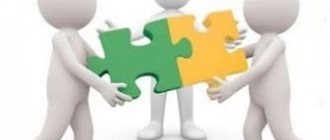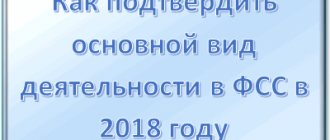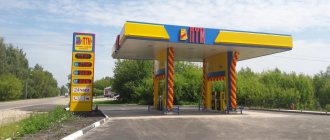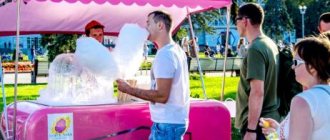A novice entrepreneur begins his acquaintance with taxation with registration and choosing a taxation system, fortunately tax legislation provides a relatively wide choice.
You can choose from a whole list of different taxation systems:
UTII (imputation), what it is and how to calculate it correctly;
USN (simplified), more details about this system here;
OSNO (general system);
But how to choose a tax system?
The first stage, alas, will not be choosing among the most optimal ones from the point of view of paying taxes, but among those that can be worked on, using here or another system. And here you need to figure out what types of activities (OKVED) fall under one or another taxation system.
For the convenience of readers, we will group them by business area; I will also wait for your questions and, as necessary, add certain areas.
In the first part, we will analyze which OKVED codes fall under UTII trade.
Types of activities for UTII by codes:
The most widespread business for imputation is retail trade, this is due to many factors, ranging from the lack of cash registers to the ease of keeping records on UTII.
Retail trade, we select OKVED that fall under UTII.
A supermarket format store with a wide range of products.
When organizing a store with a large assortment of products, including both food and industrial products, it is necessary to use
52.11 Retail sale in non-specialized stores primarily of food products, including drinks, and
But it is worth remembering that the use of this grouping implies that sales revenue consists of 50% or more of sales for food products.
52.12 Other retail trade in non-specialized stores
This group includes department stores with a wide range of goods, but revenue from food products is not the main one.
If we are talking about stores with a certain priority, then you need to choose one from the types of activities in the group
52.2 Retail sale of food products, including beverages, and tobacco products in specialized stores
That is, we are talking about specialized stores
The format of the store "At home", that is, a regular grocery store
52.21. Retail trade of vegetables and fruits
52.22. Retail trade in meat products, canned meat, as well as meat
52.23. Retail trade in seafood and fish
52.24. Retail trade of bakery products, bread and confectionery products
52.25. Retail trade of alcohol and other beverages
52.26. Retail trade of tobacco
52.27.11. Retail trade of milk and milk products
52.27.12. Retail sale of eggs
52.27.2. Retail trade in oils and fats
52.27.3 Retail sale of other food products, including flour and pasta, cereals, canned fruits, vegetables, nuts, sugar, salt, tea, coffee, cocoa. Plus, it is this OKVED that includes other products not listed in the RESOLUTION of November 6, 2001 N 454-st
Pharmacy
For a pharmacy or pharmacy we use a grouping
52.3 Retail trade of pharmaceutical and medical goods, cosmetics and perfumes
In this case, you need to enable
52.31 Retail trade of pharmaceuticals. goods, simply medicines (it is worth noting that the use of this type of activity allows for the production of drugs, but with the appropriate permits)
52.32 Retail trade of medical goods and orthopedic products
52.33 Retail trade of cosmetics and perfumes
It is worth noting that the use of this grouping is mandatory; from experience we can say that from 10 to 20% of products in pharmacies are cosmetics.
Cosmetics store
52.33 Retail trade of cosmetics and perfumes
52.44 Retail trade of furniture and household goods
In particular, it is advisable to use
52.44.2 Retail trade of various household utensils, cutlery, dishes, glass and ceramics, including porcelain and earthenware
52.48 Other retail trade in specialized stores
Particularly the group.
52.48.3 Specialized retail trade in non-food products not included in other groups
Practice shows that the assortment of cosmetics stores simply needs to include small souvenirs and “trinkets” for home decoration. Such a product allows you to increase the revenue of a retail outlet by 10-20%.
Auto parts store
50.30 Trade in automobile spare parts, components and accessories
50.40 Trade in motorcycles and spare parts for them.
If you want to do additional cycling, you need to use another group
52.48.23 Retail trade of boats and bicycles
50.50 Retail trade in oils
52.45 Retail trade of household electrical goods, radio and television equipment
Any self-respecting auto parts store should have a radio in its inventory. As a consequence, trade in household electrical goods.
The fabric store and the bedding store we talked about
52.41 Retail trade of textiles and haberdashery products
In particular, the grouping will be interesting
52.44 Retail trade of furniture and household goods
52.44.4 Retail sale of drapes, curtains and other fabric products
Clothing store
52.42 Retail trade of clothing
52.43 Retail trade of footwear and leather goods
(nobody canceled the sale of belts, bags and other accessories)
Shoe shop
Retail trade of footwear and leather goods
Plus don't forget about the groupings
52.48 Other retail trade in specialized stores
52.48.31 Retail trade in household chemicals, detergents and cleaning products.
What shoe store doesn't offer shoe care products!
As well as the OKVED grouping for UTII and simplified tax system
52.42.6 Retail sale of socks
This type of activity, although it is a side activity, can quite realistically generate 5-7% of additional revenue
Furniture store
52.44 Retail trade of furniture and household goods
52.48 Other retail trade in specialized stores
52.48.1 Specialized retail trade of office furniture
52.46.3 Retail sale of glazing materials
Household chemicals store
52.48 Other retail trade in specialized stores
52.48.31 Retail trade in household chemicals, synthetic detergents, wallpaper and floor coverings
52.44.2 Retail trade of various household utensils, cutlery, dishes, glassware and ceramics, in
including porcelain and earthenware
52.44.6 Retail sale of household products and appliances not included in other groups
Flower shop
52.48.32 Retail trade of flowers and other plants, seeds and fertilizers
52.47.3 Retail trade of stationery and stationery products
Don’t forget about the sale of cards and envelopes, which is about 5% of the revenue of any flower shop.
Plus it’s worth thinking about selling small souvenirs and gifts
52.48.34 Retail trade in souvenirs
52.43.2 Retail trade in leather goods (gifts from wallets and purses are not bad)
52.44.2 Retail trade in glass and ceramics, in
including porcelain and earthenware
Pet Shop
52.48.33 Retail trade of pets and pet food
Plus a grouping that can include everything else, from animal cages to sand.
52.48.39 Specialized retail trade in other non-food products.
Plus don't forget about
52.45.1 Retail sale of household electrical goods
Where do all kinds of electrical products for animal care belong? For example, compressors for aquariums and so on
Construction materials store
52.46 Retail sale of hardware, paints and glazing materials
be sure to add the OKVED grouping
52.48.31 Retail trade in household chemicals, detergents, wallpaper and floor coverings
Principles for selecting OKVED codes
First, it’s worth assessing the profitability prospects of your business. For example, if you receive the main profit from the product (and not from delivery), then you should exclude the code “courier services”.
Next, consider an example with a type of activity that brings rare (possibly one-time) profit.
Let's say that you are the owner of a construction company, but sometimes provide cargo transportation services. In this case, you do not have to select the OKVED code for cargo transportation; this income is minimal and inconsistent.
As practice shows, the most important thing in entrepreneurial activity is to choose several priority areas and, in accordance with your choice, select OKVED codes for individual entrepreneurs.
Now let’s take a closer look at the OKVED Classifier and understand the question of how to choose the right code for a certain type of activity.
Free legal assistance
FREE HOTLINE (ext. 196) When registering a business activity, in registration applications you must indicate the OKVED codes of the types of activities that you plan to engage in. What codes should you choose for an online store and for a regular store? What code is suitable for opening a non-specialized store of church and religious utensils (scarves, vestments, candles, wooden corners for icons and other church items.) sale both at the counter and on the Internet.
Class 46 of the OKVED-2 classifier is reserved for activities related to wholesale trade, with the exception of trade in motor vehicles. The OKVED-2 classifier is divided into sections, classes, subclasses, etc. In the article:
https://youtu.be/1X3An6Z5ork
What is OKVED?
OKVED is an all-Russian classifier of types of economic activity.
Main functions of OKVED:
- classification and coding of types of economic activity;
- providing information about the types of activities listed in the classifier.
The classifier contains the following information:
It is worth noting that OKVED does not distinguish between market and non-market, commercial and non-commercial types of economic activity, as well as between foreign and domestic trade.
OKVED uses a hierarchical classification method with a sequential coding method.
The code that groups types of economic activity consists of 2–6 digital characters.
Here is an example of such a structure:
- XX. - Class;
- XX.X - subclass;
- XX.XX - group;
- XX.XX.X - subgroup;
- XX.XX.XX - view.
For state registration, you must use at least three digital characters.
OKVED table for retail trade in 2020
Each section is responsible for a separate branch of activity.
Some types of activities do not fit certain organizational and legal forms. For example, an audit organization cannot be created in the form of an open joint-stock company.
Each of them also presents a different number of serial numbers, which are responsible for the name of the group of this branch, that is, for its branch. For example, section A is called “Agriculture and forestry, hunting, fishing and fish farming” and contains groups 01, 02 and 03 with the names “Crop and Livestock Growing”, “Forestry and Sawmills” and “Fishing”, respectively.
You can see the full table of sections and groups with decoding of codes and names below. Each group from the section has more than one serial number. However, only the basic names are presented in the main table. Each group with its serial number has a number of subparagraphs, which include a narrowing of activities and assigning a code to each subgroup, up to a six-digit All-Russian Classifier of Types of Economic Activities (hereinafter OKVED) is nothing more than one of the documents from the set of documents of all-Russian classifiers of technical -economic and social information.
How to choose an OKVED code for an individual entrepreneur yourself?
When choosing an OKVED code, you should pay attention to the existence of three classifiers:
- OKVED OK 029–2001 (NACE Rev. 1);
- OKVED OK 029–2007 (NACE Rev. 1.1);
- OKVED OK 029—2014 (NACE Rev. 2).
OKVED codes for individual entrepreneurs had to be taken from OKVED OK 029–2001. In July 2020, OK 029-2014 (NACE Rev. 2) came into force, therefore, from mid-2020 and, accordingly, to this day, OKVED codes for individual entrepreneurs in 2020 are selected from this directory.
For convenience, we recommend using the already selected OKVED codes for individual entrepreneurs. Among these codes, the most common types of business activities are:
- programming, development and testing;
- consulting, commercial activities;
- design (Internet, advertising);
- system administration and PC maintenance;
- translations;
- copywriting;
- advertising;
- marketing;
- vending;
- design (architecture, interiors, land management);
- ;
- website promotion and SEO;
- astrologers, psychics;
- renting out your own property;
- real estate activities;
- architecture;
- journalism.
Most of the registration application is occupied by the column dedicated to the choice of type of economic activity. This point is very important for the future development of your business. To fill out the column, you need to take the OKVED classifier and, choosing the code that suits your area of activity, enter it.
The first code will be the main one. It will indicate the main type of activity. The remaining OKVED codes will be additional.
It is worth paying attention to the existence of a myth that you can only engage in those types of activities that are indicated in the documents during registration. This is partly true.
Russian legislation does not prohibit carrying out business activities in the absence of an OKVED code. But there are certain points that are worth considering.
Problems may arise in the following cases:
- If a decision is made to engage in a licensed type of activity, but the code is not entered;
- If a decision is made to switch to the UTII tax regime for this type of activity;
- If a decision is made to engage in foreign economic activity, it is in this direction.
Due to the lack of OKVED codes, difficulties may arise with business lending. At the same time, we do not recommend choosing a huge number of OKVED codes, including because some of them may turn out to be licensed types of business activities.
When selecting OKVED codes for individual entrepreneurs in 2020, it is most convenient to move from the general to the specific:
- Select the field of activity in the OKVED sections (for example, “Agriculture”);
- Select a group (for example, “Crop production”);
- Select a subgroup (for example, “Cereals”);
- Select the type - this will be the code you are looking for.
In special cases, the selection of an OKVED code is not limited to one of the classes or groups of the OKVED directory. For example, when working as a designer in the field of Internet advertising, it is possible to select from different groups:
- 62.09 Activities related to the use of computer technology and information technology, other
- 73.11 Activities of advertising agencies
- 73.12 Representation in the media
- 90.03 Activities in the field of artistic creativity
- 90.01 Performing arts activities
- 62.01 Computer software development
OKVED codes for online stores, relevant in 2019
When registering the legal activity of an online store in the form of an individual entrepreneur or LLC, the question often arises of choosing codes that describe economic activity. In this article I will tell you which main and which additional OKVED codes you need to choose for an online store when submitting an application to the Federal Tax Service.
OKVED for an online store in 2020
If you have already decided on the form of ownership of your future Internet business: individual entrepreneur or LLC, when submitting documents for registration to the Federal Tax Service, you must indicate the types of activities using codes from the All-Russian Classifier of Types of Economic Activities, abbreviated OKVED. These codes allow tax authorities to monitor your activities, and your future partners and banks to understand what exactly you do.
Basic OKVED code for an online store
First of all, you need to decide on the main OKVED code. Online trading in the code directory is highlighted in a separate section
47.91 Retail trade by mail or via the Internet information and communication network.”
This section contains the following subsections:
47.91.1 Retail trade by mail 47.91.2 Retail trade carried out directly using the information and communication network Internet 47.91.3 Retail trade through Internet auctions
47.91.4 Retail trade carried out directly through television, radio, telephone
https://www.youtube.com/watch?v=484s6_wSuEw
It is recommended to indicate the general code 47.91, this will give you the right to all these activities.
Additional OKVED codes for an online store
Additional OKVED codes are needed to describe in more detail the type of activity of your business. The law does not limit the number of types of economic activity in any way, and it is better to indicate unnecessary codes than to be fined 5,000 for working in an area not related to yours (Article 14.25 of the Code of Administrative Offenses of the Russian Federation).
But keep in mind that some types of activities are subject to licensing or other accounting for taxes and insurance premiums, for example, educational or medical activities are licensed types. Fortunately, everything related to online trading today is not subject to licensing.
So, what additional activities do we need for an online store:
47.99 Other retail trade outside shops, stalls, markets
By specifying this code, you will be able to sell almost any product in your online store, with the exception of products prohibited for sale via the Internet, for example: alcohol and medications.
These goods can be sold exclusively through offline channels, and this activity is also subject to licensing. In addition, there is a separate code for selling auto parts online – 45.32.
21 Retail trade of automobile parts, assemblies and accessories via the Internet.
62.09 Other activities related to the use of computer technology and information technology
It is recommended to specify this code if you plan to create your own website with a shopping cart, connect a payment system and an online cash register to it, and also sell digital goods, such as webinars or online lessons.
If you plan to organize the delivery of orders, their packaging, storage and delivery at pickup points, it is recommended to indicate the following codes as additional ones:
53.20.31 Activities for courier delivery by various modes of transport.
52.10 Warehousing and storage activities.
82.92 Activities for packaging goods.
These codes will allow you not only to carry out these types of activities, but also to accept payments for them. For example, you will be able to charge the client for goods and payment for postal or courier delivery services by indicating these items in the check. In this case, there will be no questions from the tax authorities when receiving electronic receipts from your online store.
If you plan to sell goods not only online, but also in an office or retail store, or organize wholesale sales of your goods, then you also need to indicate codes related to these types of activities, for example, if you plan to sell fabrics, then additional codes for you will be: 46.41 Wholesale trade in textile products and 47.51 Retail trade in textile products.
When choosing OKVED codes, you must take into account that the main activity code should be exactly the code by which you will receive the most income.
Follow our blog “Life with an online store” and receive valuable advice from Internet entrepreneur Sergei Ustyuzhanin
This might also be useful:
Is the information useful? Tell your friends and colleagues
Dear readers! The materials on the TBis.ru website are devoted to typical ways to resolve tax and legal issues, but each case is unique.
If you want to find out how to solve your specific issue, please contact the online consultant form. It's fast and free! You can also consult by phone: MSK - 74999385226. St. Petersburg - 78124673429. Regions - 78003502369 ext. 257
To optimize the work on systematizing accounting and control of business entities on the territory of the Russian Federation, by Order of Rosstandart dated January 31, 2014 No. 14-st. The All-Russian Classifier of Types of Economic Activities was adopted - OK 029-2014 (OKVED). To date, a number of changes have been made to this regulatory document - in 2020, current information on codes for all types of activities is in OKVED-2. For organizations and individual entrepreneurs engaged in wholesale and retail trade, a separate section is allocated - “G”: “Wholesale and retail trade; repair of vehicles and motorcycles”, which includes 3 subsections:
- Codes for wholesale and retail trade in motor vehicles and motorcycles and their repair (subdivision 45);
- Codes for wholesale trade (division 46);
- Codes for retail trade (subdivision 47).
The directory contains 21 sections (marked with letters of the Latin alphabet from A to U), each of them is divided into several subsections (marked with numbers). The subsection includes several dozen codes, each of which corresponds to a specific type of activity.
At first glance, choosing the right code is an incredibly difficult task, but in reality everything is much simpler.
OKVED for trade in motor vehicles and motor vehicles, spare parts for them
45.11 Trade in passenger cars and light trucks
45.11.1 Wholesale trade of cars and light vehicles
45.11.2 Retail sale of cars and light vehicles in specialized stores
45.11.3 Retail trade in passenger cars and other light vehicles
45.11.31 Retail trade in passenger cars and light vehicles via the Internet information and communication network
45.11.39 Retail trade in passenger cars and other light motor vehicles, not included in other categories
45.11.4 Wholesale trade of cars and light motor vehicles for a fee or on a contract basis
45.11.41 Wholesale trade in cars and light vehicles through the Internet information and communication network for a fee or on a contract basis
45.11.49 Other wholesale trade in cars and light motor vehicles for a fee or on a contract basis
45.19 Trade in other motor vehicles
45.19.1 Wholesale trade of other motor vehicles, except passenger ones
45.19.2 Retail sale of other motor vehicles, except passenger ones, in specialized stores
45.19.3 Retail trade of other motor vehicles, except passenger vehicles, other
45.19.31 Retail trade of other motor vehicles, except passenger ones, through the information and communication network Internet
45.19.39 Retail trade of other motor vehicles, except passenger vehicles, other, not included in other groups
45.19.4 Wholesale trade of other motor vehicles, except passenger vehicles, for remuneration or on a contract basis
45.19.41 Wholesale trade of other motor vehicles, except passenger vehicles, through the Internet information and communication network for a fee or on a contract basis
45.19.49 Wholesale trade of other motor vehicles, except passenger vehicles, for a fee or on a contract basis, other
45.31 Wholesale trade of automobile parts, assemblies and accessories
45.31.1 Wholesale trade of automobile parts, assemblies and accessories, except for the activities of agents
45.31.2 Activities of agents in the wholesale trade of automobile parts, assemblies and accessories
45.32 Retail trade of automobile parts, assemblies and accessories
45.40 Trade in motorcycles, their parts, assemblies and accessories; motorcycle maintenance and repair
45.40.1 Wholesale trade in motorcycles, their parts, assemblies and accessories
45.40.2 Retail sale of motorcycles, their parts, components and accessories in specialized stores
OKVED 2 codes for wholesale trade
For business entities engaged in the wholesale trade of household goods (non-food), up-to-date information on activity codes is contained in subsection 46 of OKVED 2. The subsection contains more than a hundred codes, each of which characterizes certain specifics of the organization’s work:
Note on the table: The table lists only the main codes. You can see the full list by studying the All-Russian Classifier of Types of Economic Activities (OKVED 2).
Wholesale trade of furniture, household goods, hardware, cutlery and other metal products.
Furniture wholesale trade
Wholesale trade in hardware, knives and other household metal products
Wholesale trade in electrical goods and household electrical installation products
Wholesale trade of radio and television equipment, technical media
Wholesale trade of other household goods not included in other groups
Wholesale trade of textiles, clothing, footwear, leather and fur products.
Wholesale trade of textiles
Wholesale trade of clothing, fur products and footwear
Wholesale trade of leather goods and travel accessories
Wholesale trade of other certain types of goods. Group 46.18 includes several subgroups.
Wholesale of perfumes and cosmetics, including soap
Wholesale trade of cleaning products
Wholesale of games and toys, sporting goods, bicycles, books, newspapers, magazines, stationery and stationery, musical instruments, watches and jewelry, photographic and optical goods
Wholesale trade of paper and cardboard
Activities of agents for wholesale trade of a universal range of goods
Wholesale trade of non-food consumer goods, including wholesale trade of household items (textiles, clothing, shoes, home appliances, photo products, watches, jewelry, stationery, toys, books, newspapers).
Wholesale trade of textile products. Group 46.41 includes several subgroups (wholesale trade of yarn, woven products, table linen, etc., wholesale trade of haberdashery: sewing needles, threads, etc.).
Wholesale trade of clothing and footwear. Group 46.42 includes several subgroups (wholesale trade of clothing, footwear, underwear, fur products, hats, etc.).
Wholesale trade in household electrical goods (electrical household appliances, radio and television equipment, photographic and optical equipment, electric heaters, audio and video films, CDs and DVD digital video discs with recordings, etc.). Group 46.43 will include several subgroups.
Wholesale trade in ceramics and glass products and cleaning products.
Wholesale trade of perfumes and cosmetics, including soap.
Wholesale trade of furniture, carpets and lighting equipment. The group includes several subgroups depending on the type of goods sold.
Wholesale trade of watches and jewelry
Wholesale trade of other household goods:
- wooden objects, wickerwork and cork products, etc.;
— bicycles, parts and accessories for them;
- office supplies, books, magazines and newspapers;
— leather goods and travel equipment;
- games and toys;
- sporting goods, including special sports footwear such as ski boots
Wholesale trade of information and communication equipment, including wholesale trade of information and communication technological equipment (including computers, telecommunications equipment and their components).
Wholesale of other machinery, equipment and supplies (including agricultural implements, machinery for construction and repair, office furniture, measuring equipment, etc.)
Other specialized wholesale trade, including other specialized wholesale trade operations not classified in other groups of this section. It includes wholesale trade in intermediate consumption products, usually intended not for home use, but for industrial use (machines, equipment, fuel, building materials, timber, paper, metals, etc.)
When submitting documents for registration of a certain type of activity, a representative of the organization must indicate a code consisting of at least 4 digits. For example, when choosing wholesale trade in clothing and footwear as a type of activity, you need to indicate code 46.42 (if only 3 digits are indicated - 46.4 - registration authorities have the right to refuse registration).
OKVED code 45.3 - Trade in automobile parts, assemblies and accessories
OKVED code: - Trade in automobile parts, assemblies and accessories OKVED code 45.3: Trade in automobile parts, assemblies and accessories This group includes: - wholesale and retail trade of all types of spare parts, components, tools and accessories for vehicles, such as: rubber tires and cameras, spark plugs, batteries, lighting equipment and other parts Code - Name ★ - Wholesale trade of automobile parts, units and accessories ★ - Wholesale trade of automobile parts, units and accessories, except for the activities of agents ★ - Activities of agents for the wholesale trade of automobile parts, units and accessories ★ — Retail trade of automobile parts, units and accessories ★ — Retail trade of automobile parts, units and accessories in specialized stores ★ — Retail trade of other automobile parts, units and accessories ★ — Retail trade of automobile parts, units and accessories through information communication network Internet ★ — Retail trade of automobile parts, components and accessories by mail orders ★ — Retail trade of other automotive parts, components and accessories, not included in other OKVED groups To correctly select the main type of activity, it is necessary to take into account some points: Whether or not the selected type is subject to activity licensing.
We recommend reading: Compensation for vacation at the request of the employee
If the main type of activity is subject to mandatory licensing, then it is prohibited to carry out such activities without an appropriate license. See. Organizational and legal form of a legal entity.
OKVED 2 codes for retail trade
Business entities engaged in retail trade of household goods take information about activity codes from subsection 47 of OKEVD 2 - “Retail trade, except for trade in motor vehicles and motorcycles.”
Note to the table:
The information presented in the table is for informational purposes only. To obtain accurate information about the codes and their decoding, you must refer to the All-Russian Classifier of Types of Economic Activities (OKVED 2).
Retail trade in non-specialized (universal) stores (supermarkets):
- a diverse range of goods at the same trading enterprise.
Retail trade in stores where food products predominate.
Retail trade in stores where household goods predominate.
Retail trade in specialized stores
Retail sale of information and communication equipment in specialized stores
(computers, peripheral equipment, telecommunications equipment and consumer electronics, in specialty stores).
Retail sale of computers, peripheral devices and software in specialized stores.
Retail sale of telecommunications equipment (mobile phones) in specialized stores.
Retail trade in audio and video equipment in specialized stores.
Retail sale of other household products in specialized stores (household products - textiles, hardware, carpets, electrical appliances, furniture).
Retail trade of textiles
Retail trade in hardware, paint and varnish materials and glass in specialized stores.
Retail trade in floor coverings, carpets, textile curtains and tulle, wallpaper, etc. in specialized stores.
Retail sale of household electrical goods in special stores.
Retail sale of furniture in specialty stores.
Retail trade of a group of cultural and entertainment goods in specialized stores
Book retail
Retail trade of newspapers and stationery
Retail sale of music and video recordings.
Retail trade in sports equipment and supplies
Retail trade of toys
Retail trade of other goods in specialized stores (range of goods not presented in other sections of the classification; clothing, footwear, leather goods, pharmaceutical goods and products used for medical purposes, watches, souvenirs, cleaning products, weapons, flowers, pets and other). Subclass 47.7 includes trade in second-hand goods (second-hand bookstores, retail auctions, antiques, etc.).
Cosmetics, personal care products.
Watches, jewelry.
Retail trade in non-stationary (mobile) retail outlets, in markets with new or used goods.
Retail trade outside of stores, tents, markets (mail delivery, online stores, trading through vending machines, direct sales).
Please help make this article better. Answer just 3 questions.
Explanations and clarifications
This type of OKVED fits many types of businesses related to the transport sector. However, not everything related to transport can operate within the framework of this OKVED code. Let’s figure out what specific business entrepreneurs who have registered this particular type of activity can engage in.
Under this type of OKVED it is legal to engage in the following types of business.
1. Sell or resell under a contract wholesale and retail cars, both new and those that have already served their previous owners:
- cars;
- small cargo;
- small SUVs (up to 3.5 tons of weight);
- specialized vehicles (minibuses, ambulances, etc.).
This can be done in any way permitted by law:
- opening a specialized store;
- placing advertisements on specialized resources on the Internet;
- creating an online store;
- through teleshopping;
- placing orders by mail;
- in offices for organizing sales;
- at car markets, etc.
2. Sale or resale wholesale and/or retail of new and used vehicles, in addition to the above:
You can make a sale using all the methods mentioned above.
3. Trade motorcycles, mopeds, scooters and parts for them. This group also includes alternative vehicles such as snowmobiles, scooters, motorbikes, etc. All of the listed methods of sale and resale are legal and legal.
4. Sale of spare parts and various accessories for vehicles, directly or through agents.
Types of business not related to this OKVED code:
- auto repair;
- car wash;
- carrying out tire repairs;
- work on restoring car treads and tires;
- sale of bicycles and parts for them, as well as their maintenance and repair;
- rental of mopeds or motorcycles.
Why do you need an OKVED code?
OKVED codes are assigned to all business entities without exception. For new organizations and individual entrepreneurs, a code is assigned during the registration process:
- A business entity independently determines the activity code according to OKVED.
- An application is submitted to the registration authority, which indicates the code (or codes - there may be several of them if the organization plans to engage in several types of activities, for example, trading in shoes (code 47.71.1) and clothing (code 47.72.1)).
- After checking all the data, statistical authorities approve the assignment of a specific code to your organization.
For business entities that have decided to make changes to the constituent documents and expand the list of types of activities, it is also necessary to change or supplement the list of OKVED codes:
- Clearly define what exactly the organization plans to do.
- Find codes in the classifier that most fully reflect the essence of new types of activities.
- Submit to the body that registered the individual entrepreneur or legal entity an application indicating the relevant codes and their explanations.
- After confirmation of changes to the registration documents, the organization has the right to begin a new type of activity.
If at the moment the company is going to engage in only one type of activity, but in the future it is planned to expand the organization and introduce several more areas, then at the registration stage it is recommended to indicate several codes at once - this way you can avoid problems associated with making changes to registration documents in the future.
A business entity has the right to use several codes at the same time - their number has no restrictions. It is recommended not to abuse this opportunity and indicate no more than 20 OKVED codes at a time during the registration process.
The need to assign OKVED-2 codes to organizations and individual entrepreneurs is due to the following reasons:
- Supervisory authorities have the opportunity to simplify the regulation of economic activity (regulatory acts are developed separately for each industry).
- Using the OKVED code, it is easier for statistical authorities to track statistical data on industrial sectors.
- Tax authorities calculate tax rates based on the OKVED codes specified during registration.
- The package of documents provided by business entities during registration directly depends on the type of activity, that is, on the assigned OKVED code.
Why is it so important to indicate the correct OKVED codes when registering? There are a number of reasons for this:
- Tax rates directly depend on the type of activity, that is, on the specified OKVED code, which affects the tax burden of the enterprise, and therefore determines the cost of manufactured products or services provided.
- The OKVED code determines the need to obtain a license.
- If the code is specified incorrectly, then after the error is discovered, changes will have to be made to the registration and statutory documents, which will invariably entail time and material costs.
- If an error or inaccuracy in the indication of codes is discovered at the stage of reviewing registration documents, then organizations may refuse registration due to the deliberate indication of erroneous information about the business entity.
In order for the procedure of registration or re-registration of a legal entity or individual entrepreneur to take place without time delays and additional material costs, it is better to seek help from specialists who are familiar with all the nuances of legislation in this area.
How to choose the right OKVED code
Since it is easy to get confused in the huge number of codes for types of economic activity, we will give a simple example of choosing the right code.
- We determine the type of activity. Let's say an organization plans to engage in retail trade. This means that in the classifier we select section G, subsection 47 - Retail trade.
- Trade is planned to be organized in a specialized store. Since subclass 47.1 includes trade in department stores (non-specialized, supermarkets), we skip it and look for a group that corresponds to the type of activity of the organization.
- The company will sell textile products. This type of goods corresponds to group 47.51.
- To more accurately determine the code, you need to specifically know the group of goods planned for sale. In this case, let's assume that this is haberdashery (including sewing needles and threads). According to the classifier, this type of activity fully complies with the code “47.51.2” - Retail trade in haberdashery products in specialized stores. This is what we indicate in the registration documents as the main one.
- If, in addition to 47.51.1, the organization plans to conduct an additional type of activity, we also indicate it, for example, “47.51.1” – Retail trade of textile products in specialized stores. In this case, the company opens several specialized retail outlets (a separate retail outlet for each type of activity).
If an organization plans to engage in, say, wholesale trade in clothing (outerwear, underwear, haberdashery, hats) and shoes, it is enough to indicate the group - 46.42, without separately listing all the subgroups (46.42.11, 46.42.12, 46.42.14).
If you have even the slightest doubt about the correctness of choosing the right code, seek help from a specialist - there can be no errors or inaccuracies in such matters as choosing an OKVED code.
Please help make this article better. Answer just 3 questions.
Trade in auto parts OKVED
This is due to the fact that there are no restrictions on the number of codes selected, but the main type of activity should be highlighted. So, if an entrepreneur is engaged in retail trade and rental of vehicles.
Food trading is a common business. It is not surprising, because one of the things that people will never give up is food consumption, which means that the business is quite in demand. Many entrepreneurs connect their lives with wholesale supplies, providing local stores with goods. However, in order to start an activity, you must first register. A mandatory attribute is the OKVED code, which is necessary to classify the industry of the enterprise. Today we’ll talk about what classifier codes are needed for agents whose field of activity is wholesale trade in food products, and we’ll also find out the OKVED code for enterprises in this industry.
We recommend reading: Benefits for Disabled People 2 Gr










